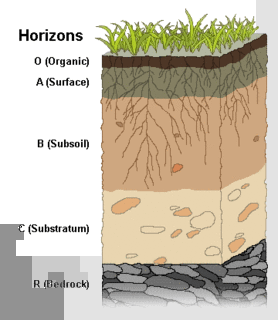
In soil science, humus denominates the fraction of soil organic matter that is amorphous and without the "cellular cake structure characteristic of plants, micro-organisms or animals". Humus significantly affects the bulk density of soil and contributes to its retention of moisture and nutrients. Although the terms humus and compost are informally used interchangeably, they are distinct soil components with different origins; humus is created through anaerobic fermentation, while compost is the result of aerobic decomposition.

Mycelium is the vegetative part of a fungus or fungus-like bacterial colony, consisting of a mass of branching, thread-like hyphae. The mass of hyphae is sometimes called shiro, especially within the fairy ring fungi. Fungal colonies composed of mycelium are found in and on soil and many other substrates. A typical single spore germinates into a monokaryotic mycelium, which cannot reproduce sexually; when two compatible monokaryotic mycelia join and form a dikaryotic mycelium, that mycelium may form fruiting bodies such as mushrooms. A mycelium may be minute, forming a colony that is too small to see, or may grow to span thousands of acres as in Armillaria.
There are a number of lines of defence against pests and diseases in the orchard, principal among these being the practice of good husbandry, creating healthy soil and ensuring high standards of garden hygiene. But no matter how diverse and healthy the garden eco-system may be, there will always be a degree of disease and pest presence. In many ways, some level of pathogen population in the garden can be not only acceptable but desirable as they are indicative of a generally healthful and diverse environment, and add to the overall robustness of the system as an immunity to such detrimental influences will build up, particularly in a balanced polycultural regime. Indeed, most of the plants we grow will tend to be selected because they are trouble free, and those that are more susceptible to attack will have fallen by the wayside over time. However, most farmers find it unacceptable that the food crops they grow are damaged by pests.

Phenol formaldehyde resins (PF) or phenolic resins are synthetic polymers obtained by the reaction of phenol or substituted phenol with formaldehyde. Used as the basis for Bakelite, PFs were the first commercial synthetic resins (plastics). They have been widely used for the production of molded products including billiard balls, laboratory countertops, and as coatings and adhesives. They were at one time the primary material used for the production of circuit boards but have been largely replaced with epoxy resins and fiberglass cloth, as with fire-resistant FR-4 circuit board materials.
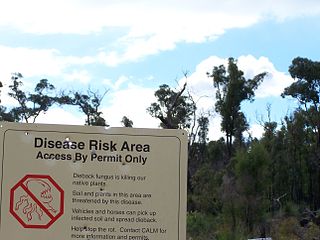
Phytophthora cinnamomi is a soil-borne water mould that produces an infection which causes a condition in plants variously called "root rot", "dieback", or, "ink disease". The plant pathogen is one of the world's most invasive species and is present in over 70 countries around the world.

Waterproofing is the process of making an object or structure waterproof or water-resistant so that it remains relatively unaffected by water or resisting the ingress of water under specified conditions. Such items may be used in wet environments or underwater to specified depths.

In trees, heart rot is a fungal disease that causes the decay of wood at the center of the trunk and branches. Fungi enter the tree through wounds in the bark and decay the heartwood. The diseased heartwood softens, making trees structurally weaker and prone to breakage. Heart rot is a major factor in the economics of logging and the natural growth dynamic of many older forests. Heart rot is prevalent throughout the world affecting all hardwood trees and can be very difficult to prevent. A good indication of heart rot is the presence of mushrooms or fungus conks on the tree.
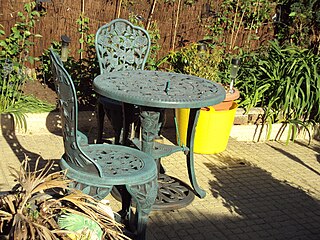
Garden furniture, also called patio furniture or outdoor furniture, is a type of furniture specifically designed for outdoor use. It is typically made of weather-resistant materials such as aluminium which is rust-proof. The oldest surviving examples of garden furniture were found in the gardens of Pompeii.
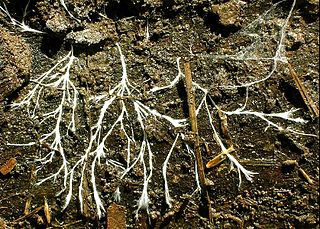
Saprotrophic nutrition or lysotrophic nutrition is a process of chemoheterotrophic extracellular digestion involved in the processing of decayed organic matter. It occurs in saprotrophs, and is most often associated with fungi and soil bacteria. Saprotrophic microscopic fungi are sometimes called saprobes; saprotrophic plants or bacterial flora are called saprophytes, though it is now believed that all plants previously thought to be saprotrophic are in fact parasites of microscopic fungi or other plants. The process is most often facilitated through the active transport of such materials through endocytosis within the internal mycelium and its constituent hyphae.

Rhizoctonia solani is a plant pathogenic fungus with a wide host range and worldwide distribution. It was discovered more than 100 years ago. R. solani frequently exists as thread-like growth on plants or in culture, and is considered a soil-borne pathogen. R. solani is best known to cause various plant diseases such as collar rot, root rot, damping off, and wire stem. R. solani attacks its hosts when they are in their early stages of development, such as seeds and seedlings, which are typically found in the soil. The pathogen is known to cause serious plant losses by attacking primarily the roots and lower stems of plants. Although it has a wide range of hosts, its main targets are herbaceous plants. R. solani is a basidiomycete fungus but the teleomorph stage is not prominent. Occasionally, sexual spores (basidiospores) are produced on infected plants. The disease cycle of R. solani is important in management and control of the pathogen. The pathogen is not currently known to produce any asexual spores (conidia), though it is considered to have an asexual lifecycle perpetuated through sclerotia.

A wood-decay or xylophagous fungus is any species of fungus that digests moist wood, causing it to rot. Some species of wood-decay fungi attack dead wood, such as brown rot, and some, such as Armillaria, are parasitic and colonize living trees. Excessive moisture above the fibre saturation point in wood is required for fungal colonization and proliferation. Fungi that not only grow on wood but permeate its fibrous structure and actually cause decay, are called lignicolous fungi. In nature, this process causes the breakdown of complex molecules and leads to the return of nutrients to the soil. Various lignicolous fungi consume wood in various ways; for example, some attack the carbohydrates in wood and some others decay lignin. The rate of decay of wooden materials in various climates can be estimated by empirical models.

Ceratocystis fimbriata is a fungus and a plant pathogen, attacking such diverse plants as the sweet potato and the tapping panels of the Para rubber tree. It is a diverse species that attacks a wide variety of annual and perennial plants. There are several host-specialized strains, some of which, such as Ceratocystis platani that attacks plane trees, are now described as distinct species.
Ramial chipped wood (RCW), also called BRF, is a type of woodchips made solely from small to medium-sized branches. The adjective "ramial" refers to branches (rami). RCW is a forest product used in agriculture for mulching and soil enrichment. It may be laid on top of the soil, mixed into it, or composted first and then applied.

Mucoromycotina is a subphylum of uncertain placement in Fungi. It was considered part of the phylum Zygomycota, but recent phylogenetic studies have shown that it was polyphyletic and thus split into several groups, it is now thought to be a paraphyletic grouping. Mucoromycotina is currently composed of 3 orders, 61 genera, and 325 species. Some common characteristics seen throughout the species include: development of coenocytic mycelium, saprotrophic lifestyles, and filamentous.
Dry rot treatment refers to techniques used to eliminate dry rot fungus and alleviate the damage done by the fungus to human-built wooden structures.

Fomes fomentarius is a species of fungal plant pathogen found in Europe, Asia, Africa and North America. The species produces very large polypore fruit bodies which are shaped like a horse's hoof and vary in colour from a silvery grey to almost black, though they are normally brown. It grows on the side of various species of tree, which it infects through broken bark, causing rot. The species typically continues to live on trees long after they have died, changing from a parasite to a decomposer.

Armillaria root rot is a fungal root rot caused by several different members of the genus Armillaria. The symptoms are variable depending on the host infected, ranging from stunted leaves to chlorotic needles and dieback of twigs and branches. However, all infected hosts display symptoms characteristic of being infected by a white rotting fungus. The most effective ways of management focus on limiting the spread of the fungus, planting resistant species, and removing infected material. This disease poses a threat to the lumber industry as well as affecting recreational areas.
Coniochaeta hoffmannii, also known as Lecythophora hoffmannii, is an ascomycete fungus that grows commonly in soil. It has also been categorized as a soft-rot fungus capable of bringing the surface layer of timber into a state of decay, even when safeguarded with preservatives. Additionally, it has pathogenic properties, although it causes serious infection only in rare cases. A plant pathogen lacking a known sexual state, C. hoffmannii has been classified as a "dematiaceous fungus" despite its contradictory lack of pigmentation; both in vivo and in vitro, there is no correlation between its appearance and its classification.
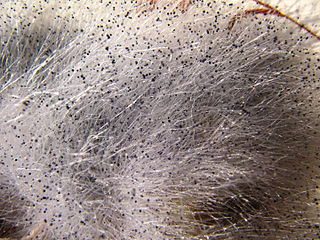
Rhizopus stolonifer is commonly known as black bread mold. It is a member of Zygomycota and considered the most important species in the genus Rhizopus. It is one of the most common fungi in the world and has a global distribution although it is most commonly found in tropical and subtropical regions. It is a common agent of decomposition of stored foods. Like other members of the genus Rhizopus, R. stolonifer grows rapidly, mostly in indoor environments.
Cladosporium ear rot is a disease that affects maize. The disease is caused by the saprophytic fungus Cladosporium herbarum and is characterized by black or dark green fungal growths that cause black streaks on kernels.















